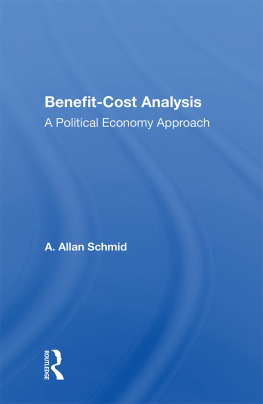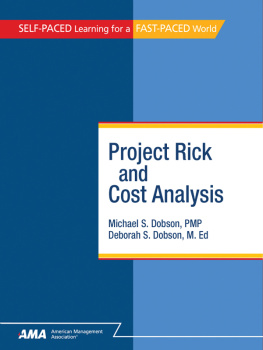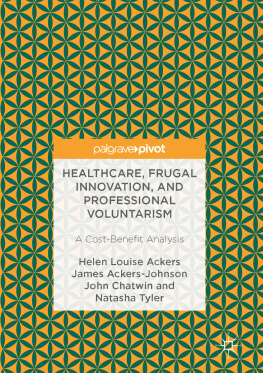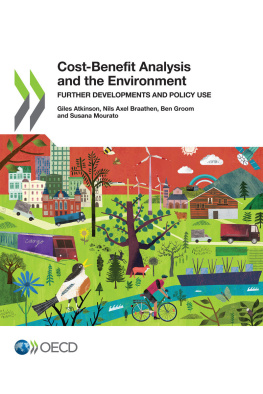First published 1989 by Westview Press, Inc.
Published 2018 by Routledge
52 Vanderbilt Avenue, New York, NY 10017
2 Park Square, Milton Park, Abingdon, Oxon OX14 4RN
Routledge is an imprint of the Taylor & Francis Group, an informa business
Copyright 1989 Taylor & Francis
All rights reserved. No part of this book may be reprinted or reproduced or utilised in any form or by any electronic, mechanical, or other means, now known or hereafter invented, including photocopying and recording, or in any information storage or retrieval system, without permission in writing from the publishers.
Notice:
Product or corporate names may be trademarks or registered trademarks, and are used only for identification and explanation without intent to infringe.
Library of Congress Cataloging-in-Publication Data
Schmid, A. Allan.
Benefit-cost analysis.
Bibliography: p.
Includes index.
1. Economic development projectsCost effectiveness.
2. Economic development projectsEvaluation. I. Title.
HD47.4.S36 1989 338.9'0068'1 88-5782
ISBN 13: 978-0-367-00316-6 (hbk)
To my family and loves: Florence, Kay, Elizabeth, Kevin, Emily, Jordan, Charles, Cindy, Lindsay, Thomas, Susan, John, Diane, James, Patrick, Daniel, those in our memories, and those yet to be born
Economists have long been known for their disciplinary epigram that there is no such thing as a free lunch. Economists tend to be, in the words of Lord Balfour, chilling skeptics. This is because they understand that everything has its opportunity cost, the forgone opportunities sacrificed in making a particular choice or undertaking any particular line of action. Another way of making the point is to say that the meaning of anything derives from an understanding of both its strengths and limitations.
Benefit-cost analysis, or BCA, has both strengths and limitations (the latter correlative to the former), and both derive from the fundamental design or nature of the tool itself. Looked at a bit differently, BCA shares the characteristics of most economic analyses, which are of the nature of models. A model is a set of variables and a set of relationships, the combination of which is used to address a problem or set of problems. Not all possible variables are included in any one model, and not all possible relationships are hypothesized in any one model. Thus, there can be many models, with varying sets of variables and varying sets of relationships adduced to exist among the variables, and also quite different models that address quite different problems. Furthermore, because they include neither all variables nor all possible relationships between the variables actually included, models do not presume to replicate or substitute for the real world in all its variegated and kaleidoscopic complexity. One important consequence is that estimation or prediction within the context of a model is different from estimation or prediction in the real world.
P = MV/T, the equation frequently used to state the quantity theory of money, is a model. It attempts to explain the price level, P, in terms of the three other aggregative variables M, V, and T (somehow specifically defined) in certain ways. There are other models capable of addressing the determination of the price level and also several ways of utilizing (making further assumptions about) M, V, and T. Moreover, the model itself cannot determine what will happen to the price level in the future in the real world, and even with additional data and/or assumptions the predictive capacity of the model is problematic and controversial. It will not escape the reader that whatever one thinks about the nature of economic reality (whatever that phrase may connote), there is inescapable subjectivity present in determining (1) that the problem on which to focus is the price level; (2) that this, rather than some other model, is the one worth using; (3) what the further, amplificatory assumptions should be; and so on. The use, then, of the quantity theory of money is laden with all sorts of implicit qualifications; that is to say, it has a distinctive set of strengths and limitations. So it is with benefit-cost analysis.
Alas, because economists are human beings and share the capacity for myopia with their fellow human beings, including the presumption of the validity of those techniques that constitute the tools of the discipline, there are both sophisticated and naive understandings and usages of techniques such as benefit-cost analysis. Even when used correctly and with a sense of its limitations, the technical analytic meaning and policy significance of BCA derive from both its strengths and limitations. When used in an improper, naive, or question-begging way, the situation is serious to the point of grievous numerology. It is the genius of this book to seriously indicate how to avoid such naivete and misuse.
The attractiveness and wide use of benefit-cost analysis derive from several sources. First, economists (1) typically very much want to have something significant to say about policy and (2) are expected by noneconomists to have something important to say about policy. Second, inasmuch as economics deals with prices, costs, benefits, and the details of complex decision making under the rubric of constrained maximization, it is to be expected that the status of the discipline, in the minds of both economists and noneconomists, would depend on the abilities of its practitioners to apply those concepts to real world problems. Third, BCA appears particularly coherent and persuasive because of the concatenation of two circumstances: the predominance of utilitarian modes of thought and of pecuniary, calculatory ways of life--so much so that the two tend to merge in our understanding. Fourth, it must be acknowledged that BCA is a technique that readily accommodates those analysts and policy makers who want to wrap the policy implications of their subjective policy preferences in the cloth of seemingly objective technique, so that (to change the metaphor) policy masquerades as science for purposes of legitimation and political mobilization or consensus formation. Those who want to control policy seek, in part, to control the definition of reality, and BCA has been an object of capture and use so as to define reality in some preferred way rather than another. So, far from being wholly and solely an objective tool, BCA has been part of the processes of argument and social control, not transcendental to either.
What distinguishes Allan Schmid's book is his effort to present BCA as a tool of analysis and not as a neutral black box substitute for policy making. He demonstrates that BCA is more complex and at all stages more laden with fundamental assumptions than is sometimes seriously presented in the textbooks or, more widely, realized or acknowledged by its practitioners. In one sense, it is true that BCA is a neutral tool. Like a computer, one gets out of it what one puts into it; like a hammer, what it does and accomplishes depends on its use. But this means that in another sense, if one understands the tool as also comprising its users' subjective uses of it, it is not neutral; it is an extension, and instrument, of the user. In other words, the meaning of BCA depends on the sum of its strengths and its limitations. This point has never been briefly stated so well as by John Maynard Keynes in his introduction to the volumes in the Cambridge Economic Handbook series in the period between the two world wars: "The Theory of Economics does not furnish a body of settled conclusions immediately applicable to policy. It is a method rather than a doctrine, an apparatus of the mind, a technique of thinking, which helps its possessor to draw correct conclusions." One has only to add that the "correctness" of the conclusions derives not solely from the technique of analysis per se but also, and arguably much more so, from the data that one uses in conjunction with the technique.












